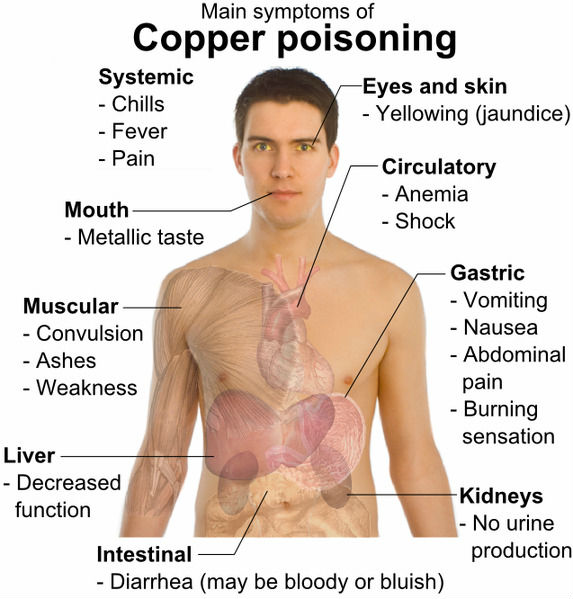- Copper is one of the essential micronutrients for humans. It plays an important role in human health, and the major way of absorbing the required amount of copper each day is through eating and drinking. On the other hand, if the level of absorption is not enough, the causes and effects can be as follows:
- First of all, copper is the ingredient of several important enzymes in the body, which promote absorption and utilization of iron, maintaining the function of the central nervous system. So lack of copper will indirectly cause anemia, increasing the brittleness of various blood vessels and bones in the human body, brain atrophy, mental and physical development defects and negative effects on the endocrine and nervous systems. In addition, it also may cause vitiligo and prematurely grey hair due to melanin loss.
- Secondly, copper deficiency in children will cause pantatrophia, chronic diarrhea, weight loss, hepatosplenomegaly, stunted growth, pale skin, hair turning from black to yellow, low pigment anemia and. Some children also show a skin rash, superficial veins, low muscle tone and osteoporosis.
- In addition, another disease called "wire sample hair syndrome", although rare, belongs to a congenital defect which is caused by the copper metabolism. Its main manifestation is that hair is not only hard and curly but also light in color. And the patient’s face looks pale, brain development is affected and intelligence is low, etc.
- Copper deficiency can also cause low blood iron, low blood copper and low serum protein syndrome — "the three low syndrome" for short — the name of the disease accurately reflecting its diagnosis in clinical examination. Symptoms include low pigment anemia, pale face, edema, liver and spleen enlargement, irritability, stunted growth and development. It’s not clear yet whether pathogenesis, may be due to serious lack of copper. Treatment of this disease should adopt comprehensive therapy, at the same time as blood transfusion, with copper and iron preparations being supplied together, to enhance comprehensive and balanced nutrition.
- In addition, copper deficiency can indirectly lead to diseases such as myocardial infarction, coronary heart disease and osteoporosis.
- Therefore, the importance of copper to human health should not be ignored.
- But do you know what foods are rich in copper? The following are for your reference:
- 1. Most nuts (especially brazils and cashews), seeds (especially poppy and sunflower) and chickpeas.

- 2. Liver and oysters.
- 3. Some natural foods such as cereals, meat and fish, which can generally contain sufficient copper to provide up to 50% of the required copper intake in a balanced diet.
- 4. Drinking water which is transmitted through copper pipes.
- Copper is a heavy metal that is toxic in its unbound form. Almost all of the copper in the body is bound to proteins, thereby reducing the concentration of unbound copper ions to almost zero. Most diets contain enough copper (2-5mg daily) to prevent a deficiency and not enough to cause toxicity. The World Health Organization (WHO) suggests that 10-12mg per day may be the upper safe limit for consumption.
- Causes of copper toxicity
- Copper toxicity is usually due to:
- Excessive supplementation
- The increasingly common problem of low levels of zinc in the diet
- Contaminated food and drinking water due to contact with metallic copper
- External exposures such as a copper IUD or accidental agricultural overspray
- Elevated levels of estrogens
- The main symptoms of copper poisoning is as follows:

- In addition, since copper and zinc compete with each other for absorption in the gut, copper toxicity has been the subject of greater concern in recent years. This is primarily due to reduced zinc in the diet and the switch from galvanized to copper water pipes. Acidic water such as rain water, left standing in copper plumbing pipes, can be a source of toxicity when consumed. In prolonged contact with copper cooking utensils, an acidic food or beverage can dissolve milligram quantities of copper, sufficient to cause acute toxicity symptoms such as self-limited nausea, vomiting and diarrhea. High copper levels, especially when associated with low zinc levels, have been linked to a variety of symptoms and conditions.
- Source: http://www.diagnose-me.com/symptoms-of/copper-toxicity.html
-
About us
Contact us
Make a suggestion
- Metalpedia is a non-profit website, aiming to broaden metal knowledge and provide extensive reference database to users. It provides users reliable information and knowledge to the greatest extent. If there is any copyright violation, please notify us through our contact details to delete such infringement content promptly.


